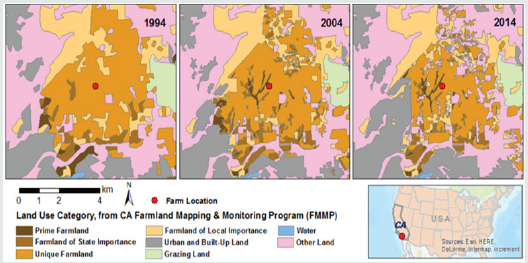Agriculture open access journals | Lupine Publishers
Farming at the Peri-Urban Fringe
Figure 1: Land use change in the period 1994 - 2014 showing pressure of urban development on agricultural land. The red dot
in each panel indicates one of the farms in San Diego Co. that has experimented with coffee-avocado intercropping.

Ranked #1 in U.S. crop production and accounting for over 12%
of the U.S. population [6,7]. the state of California (CA), serves as a
prime example of the challenge described above. The state has long
provided a significant proportion of the fruits and nuts consumed in the
U.S., and it alone accounts for 86% of national avocado
production. Demographic pressure is at the root cause of CA’s rapid
land use change. Recent census data indicate that in the period
from 1990 to 2000 CE alone, over 10 million housing units were
added in the state, highlighting the trend of sustained urban growth
(Figure 1). Estimates suggest that, by 2050, over 12 million acres
of farmed land or rangeland will be lost to development in CA [4].
According to recent data (FMMP; www.conservation.ca.gov), prime
irrigated farmland characterized by high soil quality and large
contribution to the food market—has been the most vulnerable of
all agricultural land to urbanization, likely due to the fact that a
large
portion of this fertile land is located in the proximity of developed
areas [8]. Land loss to residential development threatens the longterm
sustainability and profitability of CA’s tree crop agriculture,
but so too does the ongoing drought and future impacts of climate
change. Improving soil health by building soil organic carbon (SOC)
in these agricultural systems can act as critical tools to increase
resilience to drought and offset greenhouse gas (GHG) emissions.
If adopted with limited water application, intercropping—the
practice of simultaneously growing two crops on the same land [9].
can represent an ecologically and financially valuable solution to
issues pertaining to food sourcing and resource use. Intercropping
boosts productivity, increases SOC, and enhances nutrient and
water retention [10].
The Case for California Grown Coffee
Like many self-described pioneers, new coffee farmers in coastal California employ various approaches to sustainability, community development, and organic growing. All of these actions take place on historical landscapes that have experienced various forms of agricultural and urban or suburban development. California is a major breadbasket, fruit dish, and salad bowl while simultaneously becoming the most urbanized landscape in the country [11]. Scarcity (water, land, population pressures, restricted zoning) has imposed constraints but also foresight on growers, leading to new models of innovation and sustainability. Similar to other niche, high-end cultivars endemic to CA agriculture (i.e. wine, almonds), sustainable coffee is intricately linked to consumers interested in provenance, methods, and compelling stories connecting them to their food. This, too, is another integral part of what has become known as California Cuisine pioneered in the 1970s by Alice Waters. Growers espouse and practice various agrarian philosophies related to sustainability, community development, and organic growing. These farmers also face common challenges related to city and county zoning, other farmers, wine producers, citrus growers, and even residents with different visions of what CA landscapes should look like.
Conclusion
For more Lupine Publishers Open Access Journals Please visit our website: https://lupinepublishersgroup.com/
For more agriculture open access journals Please Click Here:
https://lupinepublishers.com/agriculture-journal/
To Know More About Open Access Publishers Please Click on Lupine Publishers

No comments:
Post a Comment
Note: only a member of this blog may post a comment.